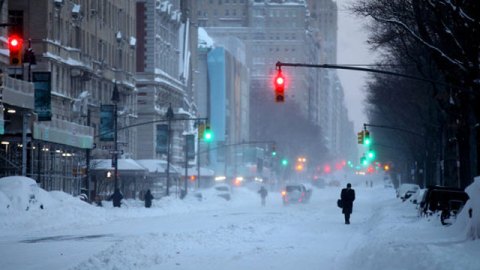What’s Behind the Monster Snowstorms?

To understand the many forces behind the current surge in snow storms, you have to understand where they come from. Basically, cold Arctic air sweeps down from Canada, and eventually collides with moist, humid air from the Gulf of Mexico. The collision produces show storms which then climb up the Northeast corridor.
Common sense tells us that freezing air is the main driver of monster snow storms. The reality is more complex. Many factors influence the strengh of a snow storm, especially amount of moisture in the air. Think of making ice cubes in a refrigerator. The more water in the ice tray, the more ice cubes you make. Lowering the temperature of the refrigerator mainly makes the water freeze faster, but has no effect on the amount of ice produced. (After all, it does not matter if the ice is at 30, 31, or 32 degrees.) Similarly, one of the main drivers of huge snow storms is less the freezing temperature, and more the moisture in the warm air.
There is no single smoking gun as to what is behind the current snow storms. But, we have two theories:
a) It could be random fluctuations. For example, we had the tail-end of El Nino last year, which disrupted the jet stream and created more warm water currents. This year, we had no El Nino.
b) It could be global warming. This might heat up the waters of the Gulf of Mexico, creating more moisture, and hence creating more snow storms. This violates common sense, but common sense is often wrong.
No one knows precisely what is causing the current snow storm activity. Anyone who claims to know exactly what is driving the weather probably does not know what they are talking about.
But it is consistent with global warming. For example, 2010 went down as the one of the hottest years ever recorded by science (tied with 2005) since records were kept in 1880. But we also have vastly different weather conditions in other parts of the world. This is because global warming causes increasingly large swings in the weather. Global warming is not a uniform process, but one which causes flooding in one area, droughts in another, snow storms in another, and heat spells in yet another. I was speaking in Brazil two weeks ago, where there were record mud slides, which were caused by massive flooding and probably due to more moisture in the air.
Think of pushing a child on a swing. Adding energy to the swing does not make it rise farther and then stop. Adding energy makes the kid’s swings much larger. Similarly, adding energy to the earth does not make temperatures rise uniformly. It causes swings instead. So global warming should actually be called global swings. Of course, this is a controversial topic. But the controversy revolves around whether human activity is driving this increase in weather. There is almost no disagreement that the earth itself is heating up (the disagreement is over what is causing it).
What does this mean for the future? I don’t know.
But if the earth continues to heat up, and more moisture is released into the atmosphere, it might mean more snow storms and hurricanes. Get used to it.
Photo Credits: Ruttle/AP (NY Daily News – 2010 Christmas Snowstorm)





